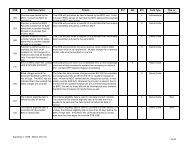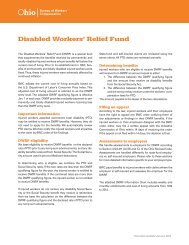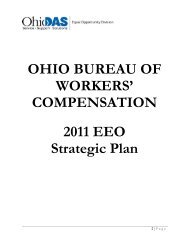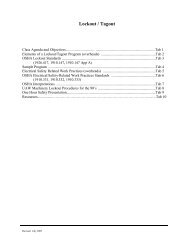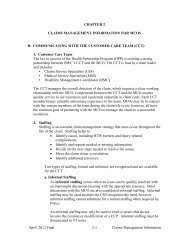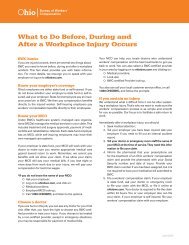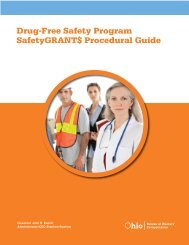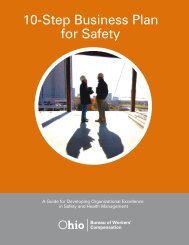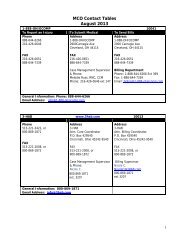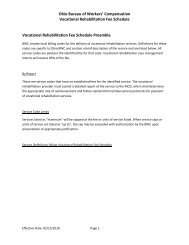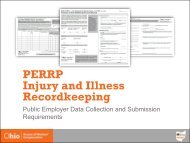DEVELOPING JOB SAFETY ANALYSIS
DEVELOPING JOB SAFETY ANALYSIS
DEVELOPING JOB SAFETY ANALYSIS
Create successful ePaper yourself
Turn your PDF publications into a flip-book with our unique Google optimized e-Paper software.
346 Developing Job<br />
Safety Analyses<br />
(JSAs): It’s Easier<br />
Then You Think<br />
Click to insert presenters<br />
Ted Whitlinger, CSP, ARM<br />
Thursday, March 29, 3:45 to 4:45 p.m.<br />
Click to insert session day, date and time<br />
<strong>DEVELOPING</strong> <strong>JOB</strong><br />
<strong>SAFETY</strong> <strong>ANALYSIS</strong><br />
IT’S EASIER THAN YOU THINK<br />
How to implement a simple & effective JSA program<br />
March 29, 2012<br />
Ted Whitlinger, CSP, ARM<br />
Casualty Risk Control Consultant<br />
Willis of Ohio<br />
775 Yard Street, Columbus, OH 43215<br />
Direct: 614-326-4869 Mobile: 614-747-6782<br />
ted.whitlinger@willis.com<br />
<strong>JOB</strong> <strong>SAFETY</strong> <strong>ANALYSIS</strong><br />
Learning Objectives<br />
•Define Job Safety Analysis (JSA) process<br />
in simple terms<br />
•Describe purposes and benefits of JSAs<br />
•Recognize different JSA approach<br />
methods and formats<br />
•Explain primary steps to conduct effective<br />
JSAs<br />
WHAT IS <strong>JOB</strong> <strong>SAFETY</strong><br />
<strong>ANALYSIS</strong>?<br />
Procedure or technique to examine job tasks<br />
and methods to identify existing and potential<br />
hazards so they can be eliminated or reduced<br />
to acceptable levels.<br />
•Also known as Job Hazard Analysis (JHA)<br />
•No current OSHA standards for JSAs but<br />
guidelines for JHAs provided in OSHA<br />
publication #3071<br />
•OSHA is likely to review your hazard assessment<br />
program (PPE, PSM, BBP, VPP, etc)<br />
2<br />
3<br />
WHY CONDUCT<br />
<strong>JOB</strong> <strong>SAFETY</strong> <strong>ANALYSIS</strong>?<br />
•Identify existing hazards<br />
•Identify potential hazards<br />
•Determine safest, most<br />
efficient way to do the job<br />
•Prioritize corrective actions<br />
…before accidents occur<br />
BENEFITS & USES OF JSAs<br />
•Reduce injuries and protect employees<br />
•Examine activities and behavior in addition to<br />
physical conditions<br />
•Discover undetected hazards and possible<br />
improvements in job methods<br />
•Increase quality and productivity<br />
•Comply with OSHA’s requirements for PPE<br />
hazard assessment<br />
4<br />
5<br />
1
BENEFITS & USES OF JSAs<br />
•Customized and standardized job training<br />
tool with safety built right in<br />
job orientation<br />
group meetings<br />
employee coaching<br />
•Demonstrate interest/concern for safety<br />
•Employee involvement in safety – better<br />
safety attitudes<br />
•Accident/incident investigation<br />
JSA EFFECTIVENESS<br />
Why are JSAs more effective at reducing<br />
accidents than walk-around inspections???<br />
6<br />
7<br />
STEPS TO CONDUCT JSAs<br />
1.Select the job(s) to be analyzed<br />
2.Break down the job into basic steps (or<br />
tasks or activities)<br />
3.Identify the hazards of each step<br />
4.Develop controls for the safest way to do<br />
the job<br />
1. SELECT <strong>JOB</strong>(S)<br />
•Accident frequency/severity rates – worst first<br />
•Near miss events<br />
•Potential for severe injuries<br />
•New, infrequent, seasonal, or unusual tasks<br />
•Changes involving equipment, processes, or<br />
environments<br />
8<br />
9<br />
1. SELECT <strong>JOB</strong>(S)<br />
Good candidates for JSAs may involve:<br />
• Work at heights<br />
• Confined space entry<br />
• Moving machinery/equipment or automation<br />
• Chemical exposures<br />
• Stored energy<br />
• Potential for fire/explosion<br />
• Lifting/carrying heavy objects<br />
• Repetitive tasks<br />
2. BREAK DOWN THE <strong>JOB</strong><br />
INTO STEPS<br />
• Select the right employee to observe – experienced, capable,<br />
cooperative, willing to share ideas<br />
• Explain the purpose – evaluation of job methods, not<br />
evaluation of individual performance<br />
• Observe the job (and/or photograph h or videotape) and involve<br />
the employee by asking questions<br />
• Record each step in sequence – use simple terms, not too<br />
broad or too narrow<br />
• Include abnormal or upset conditions<br />
• Verify with the employee – revise if necessary – thank for<br />
cooperation<br />
10<br />
11<br />
2
Job Safety Analysis Worksheet<br />
Job:<br />
Analysis By:<br />
Reviewed By:<br />
Approved By:<br />
Date:<br />
Date:<br />
Date:<br />
Sequence of<br />
Potential Accidents or<br />
Preventative<br />
Steps<br />
Hazards<br />
Measures<br />
3. IDENTIFY THE HAZARDS<br />
Use “What If” Questions and Scenarios<br />
•What can go wrong?<br />
•What are the consequences?<br />
•How H could it arise?<br />
•Other contributing factors?<br />
•How likely is it that the<br />
hazard will occur?<br />
12<br />
13<br />
3. IDENTIFY THE HAZARDS<br />
•Close observation, knowledge, and discussion<br />
•List all hazards (actual and potential)<br />
including ergonomic risk factors<br />
•Verify details with employee (and others)<br />
•Repeat as needed<br />
•Revise if necessary<br />
4. DEVELOP CONTROLS<br />
Hierarchy of Safety Controls<br />
•Elimination<br />
•Substitution<br />
•EngineeringE i i<br />
•Warnings<br />
•Administrative<br />
•PPE<br />
(From ANSI Z.10)<br />
14<br />
15<br />
4. DEVELOP CONTROLS<br />
Strategies…<br />
•Find a new way to do the job<br />
•Change the physical conditions that create<br />
hazards<br />
•Change the work procedure<br />
•Reduce necessity or frequency<br />
•Provide PPE<br />
**Avoid general statements such as “be alert”, “be careful”, or<br />
“use caution”<br />
16<br />
17<br />
3
<strong>JOB</strong> <strong>SAFETY</strong> <strong>ANALYSIS</strong><br />
Learning Objectives<br />
•Define Job Safety Analysis (JSA) process<br />
in simple terms<br />
•Describe purposes and benefits of JSAs<br />
•Recognize different JSA approach<br />
methods and formats<br />
•Explain primary steps to conduct effective<br />
JSAs<br />
18<br />
<strong>DEVELOPING</strong> <strong>JOB</strong><br />
<strong>SAFETY</strong> <strong>ANALYSIS</strong><br />
IT’S EASIER THAN YOU THINK<br />
How to implement a simple & effective JSA program<br />
March 29, 2012<br />
Ted Whitlinger, CSP, ARM<br />
Casualty Risk Control Consultant<br />
Willis of Ohio<br />
775 Yard Street, Columbus, OH 43215<br />
Direct: 614-326-4869 Mobile: 614-747-6782<br />
ted.whitlinger@willis.com<br />
o Points of view, ideas, products, demonstrations<br />
or devices presented or displayed at the Ohio<br />
Safety Congress & Expo do not constitute<br />
endorsements by BWC. BWC is not liable for<br />
any errors or omissions in event materials.<br />
4




